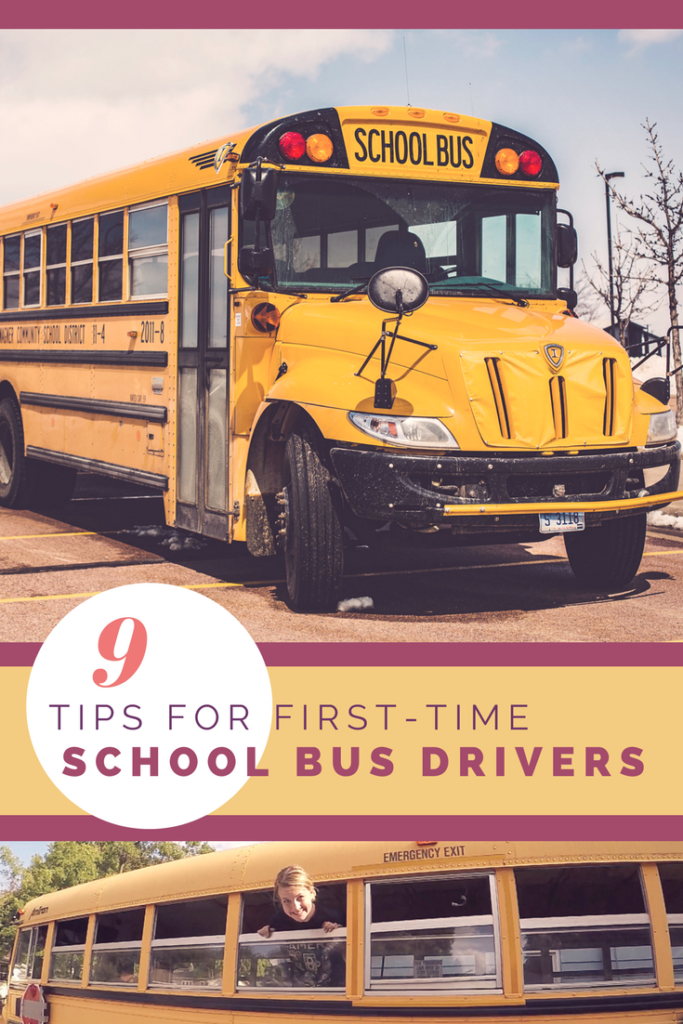9 Tips for First Time School Bus Drivers

Driving a school bus seems extremely intimidating if you’ve never driven one before. It is definitely a learning curve but if you apply the following tips, you’ll be on the road in no time.

1. Check all of the mirrors.
Make sure that the mirrors are properly adjusted before every trip. Every mirror is like another set of eyes. Make sure to get a good idea of where your blind spots are and what your range of vision is.
A good rule of thumb while driving is to check every mirror every 5 seconds and before you slow down.

2. Make sure to perform pre and post trip inspections.
Pre & Post trip inspections are super important, especially with large vehicles. Front tires need 4/32 of tread and back tires need 2/32 of tread to drive legally and safely.
We will be posting more details on thorough pre and post trip inspections in a future post.
3. GOAL – Get out and look.
Before leaving, walk around your vehicle to get a visual of what your surroundings are like. When in doubt, get out and look. It’s never worth it to take a chance to see if you can make a turn. Always get out and look because you won’t get a second chance.

4. Get to know your gages.
Features, such as hydraulic brakes or air brakes, vary depending on the type of bus you have. If your bus has air brakes, it will have air tank gauges.
You must always keep your eye on these gauges because if you run out of air in your air tanks, your brakes will malfunction. Once it gets down to 60 psi, there should be an alarm that goes off, but it’s still best practice to pay attention to these levels.
Also be mindful of the temperature gauge. Buses often overheat while driving at high RPMs. There is a difference between a city bus and a highway bus. Most school buses are meant for in-town driving but some are also able to drive on the interstate. Just be mindful of the temperature when you’re driving at higher RPMs.
5. Make sure to read every road sign.
This may seem like common sense. However, if you’re used to driving a car, you may not realize that some roads or areas do not allow bigger vehicles like trucks or buses. This can also be true in certain areas where there is road construction.

6. Keep your eyes ahead and give yourself time to stop.
Keep your eyes 12 seconds ahead of you. If you can’t see 12 seconds ahead, slow down. On average, most people only look 2-3 seconds in front of them. Remember your school bus isn’t a car. Some buses weigh 30,000+ pounds so they’re much harder to stop.
Additionally, buses are usually 2-3 cars in length and it’s crucial to keep those factors in mind. You need to pay closer attention to when you’re breaking in a bus than in a car. With larger and heavier vehicles, it’s important to give yourself extra time to stop.
7. Always have an exit plan.
When you enter any sort of location, parking lot, etc always eye an “out” for your vehicle. Never enter a parking lot without a plan for exiting. It can become a serious problem if you pull into a lot and your bus can’t turn around. The last thing you want is to have to back up your bus into oncoming traffic.

8. Remember that buses are very long vehicles.
As mentioned before, buses can be 2-3 times the length of a car, so it’s important to remember this when driving a bus.
When taking a right at an intersection, it’s important to hook the nose of the bus slightly into the inside lane before beginning to turn. Make sure to yield to other vehicles before doing this.
This allows you extra room to get around the corner. When taking left turns through an intersection you need to take full 90-degree turns.
9. Find a place to practice.
Before you venture out into the town with your new bus, make sure to find a place that’s not busy, like a country road or a large (and mostly empty) parking lot, and get comfortable. Try the brakes, try turning, and get a feel for how your bus drives.
Don’t forget to sign up for more bus conversion info and updates right to your inbox!
We solemnly swear that we will not spam you. 🙂




